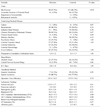Abstract
Purpose
Our study was done to evaluate the influence of postoperative delirium on the prognosis of hip arthroplasty, and risk factors for postoperative delirium in individuals older than 65.
Materials and Methods
Among patients who received hip arthroplasty in our hospital (WCH) between March 2004 and March 2008, we chose 193 patients for our study after excluding patients who had preoperative delirium and who had a history of dementia and cognitive dysfunction. We divided our cohort of 193 patients into two groups, 131 patients with postoperative delirium and 62 patients without delirium. We checked for clinical results for hip arthroplasty. We checked for multiple factors related to delirium.
Results
The mean hospital stay was 42.4±14.0 in the delirium group and 20.4±4.3 in the control group; the difference was significant. The mean preoperative cumulative ambulation score was 1.9±1.2 in the delirium group and 3.1±1.7 in the control group; the difference was significant. In 2 individuals of the control group and 4 of the delirium group, dislocation developed;and there was significant difference. There was a high prevalence of delirium among patients with hip fractures, and of histories of psychiatric diseases, alcohol abuse, liver cirrhosis and cerebral vascular disease. The delirium group had a significantly longer stay in the intensive care unit. On admission, the delirium group had significantly lower sodium and albumin compared to controls.
Figures and Tables
References
1. American Psychiatric Association. Diagnostic criteria from DSM-IV-TR. 2000. Washington, DC: ; : American Psychiatric Association.
2. Marcantonio ER, Flacker JM, Wright RJ, Resnick NM. Reducing delirium after hip fracture: a randomized trial. J Am Geriatr Soc. 2001. 49:516–522.

3. Robinson TN, Raeburn CD, Tran ZV, Angles EM, Brenner LA, Moss M. Postoperative delirium in the elderly: risk factors and outcomes. Ann Surg. 2009. 249:173–178.
4. Brauer C, Morrison RS, Silberzweig SB, Siu AL. The cause of delirium in patients with hip fracture. Arch Intern Med. 2000. 160:1856–1860.

5. Flinn DR, Diehl KM, Seyfried LS, Malani PN. Prevention, diagnosis, and management of postoperative delirium in older adults. J Am Coll Surg. 2009. 209:261–268. quiz 94.

6. Francis J, Martin D, Kapoor WN. A prospective study of delirium in hospitalized elderly. JAMA. 1990. 263:1097–1101.

7. Inouye SK. Prevention of delirium in hospitalized older patients: risk factors and targeted intervention strategies. Ann Med. 2000. 32:257–263.

8. Bitsch M, Foss N, Kristensen B, Kehlet H. Pathogenesis of and management strategies for postoperative delirium after hip fracture: a review. Acta Orthop Scand. 2004. 75:378–389.

9. Marcantonio ER, Goldman L, Mangione CM, et al. A clinical prediction rule for delirium after elective noncardiac surgery. JAMA. 1994. 271:134–139.

10. Park CT, Yang HI, Sung KB, Shin HG, Park HK. Analysis of risk factors related to delirium tremens in alcohol withdrawal seizure patients. J Korean Neurol Assoc. 1996. 14:543–547.
11. Kat MG, Vreeswijk R, de Jonghe JF, et al. Long-term cognitive outcome of delirium in elderly hip surgery patients. A prospective matched controlled study over two and a half years. Dement Geriatr Cogn Disord. 2008. 26:1–8.

12. Kalisvaart KJ, de Jonghe JF, Bogaards MJ, et al. Haloperidol prophylaxis for elderly hip-surgery patients at risk for delirium: a randomized placebo-controlled study. J Am Geriatr Soc. 2005. 53:1658–1666.

13. Warshaw G, Mechlin M. Prevention and management of postoperative delirium. Int Anesthesiol Clin. 2009. 47:137–149.

14. Gustafson Y, Brännström B, Berggren D, et al. A geriatric-anesthesiologic program to reduce acute confusional states in elderly patients treated for femoral neck fractures. J Am Geriatr Soc. 1991. 39:655–662.

15. Edlund A, Lundström M, Lundström G, Hedqvist B, Gustafson Y. Clinical profile of delirium in patients treated for femoral neck fractures. Dement Geriatr Cogn Disord. 1999. 10:325–329.

16. Schuurmans MJ, Duursma SA, Shortridge-Baggett LM, Clevers GJ, Pel-Littel R. Elderly patients with a hip fracture: the risk for delirium. Appl Nurs Res. 2003. 16:75–84.

17. Beloosesky Y, Hendel D, Weiss A, et al. Cytokines and Creactive protein production in hip-fracture-operated elderly patients. J Gerontol A Biol Sci Med Sci. 2007. 62:420–426.

18. Litaker D, Locala J, Franco K, Bronson DL, Tannous Z. Preoperative risk factors for postoperative delirium. Gen Hosp Psychiatry. 2001. 23:84–89.

19. Morimoto Y, Yoshimura M, Utada K, Setoyama K, Matsumoto M, Sakabe T. Prediction of postoperative delirium after abdominal surgery in the elderly. J Anesth. 2009. 23:51–56.





 PDF
PDF ePub
ePub Citation
Citation Print
Print





 XML Download
XML Download